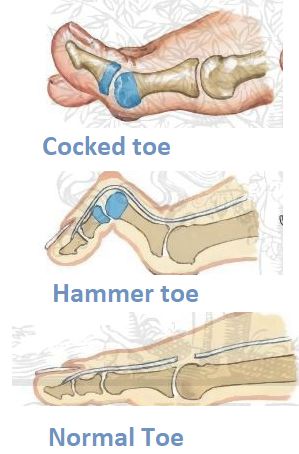Cocked toe
/kɑkt/ /toʊ/
1. [noun] the big toe, called the Hallux, is made up of two small bones called phalanges. This condition presents as a cocking up of the big toe at the joint between these two small bones. In the early stages of the condition the deformity is flexible, in later stages the deformity becomes rigid. It is caused by a variety conditions. Neurological diseases that cause muscle weakness or muscle imbalance in the muscles of the lower leg can result in the formation of Hallux hammertoe. This is commonly seen in patients after they have suffered a stroke or Cerebral Vascular Accident. Damage to certain areas of the brain during a stroke will frequently result in weakness and/or paralysis on one side of the body. If the stroke is not severe the patient may recover a majority of the function of the muscles in the legs and feet. However a residual result may be a cocking up of the big toe. A high arched foot may also result in the formation of, not only a hallux hammertoe, but also hammertoes of all of the toes. A consequence of having a hallux hammertoe is irritation on the top of the toe from shoe pressure or the development of a painful callus on the end of the big toe. People who have had a stroke or who have diabetes with peripheral neuropathy may not have pain associated with the callus on the end of the toe. These areas may ulcerate and become infected. See http://podiatrynetwork.com/common-disorders/195-cocked-up-big-toe-hallux-hammer-toe ; Accessed May 8 2019 Image source: Tannis Sorge Image source: Tannis Sorge
Source: http://podiatrynetwork.com/common-disorders/195-cocked-up-big-toe-hallux-hammer-toe



Frequently Asked Questions
How does a cocked up big toe differ from a typical hammertoe seen in the smaller toes?
A cocked up big toe specifically involves an upward bending at the joint between the two phalanges of the hallux, while hammertoes usually affect the lesser toes with a different bending pattern.
How might everyday activities reveal a cocked up big toe during normal movement?
During walks or routine motions, the misalignment of the hallux can become visible, especially when wearing stiff or narrow footwear that highlights the abnormal bending at the toe’s joint.
Does the term 'Hallux' provide any memory hints related to a cocked up toe condition?
Absolutely. 'Hallux' is derived from Latin meaning the big toe, which helps recall that this condition specifically involves the primary toe and distinguishes it from similar issues affecting other toes.